Vineyard is a true family affair
21st August 2024
Fruit & Vine editor, Rachel Hicks spoke with Ellie Wilson, the latest generation of the Wilson family to work at Little Wold Vineyard in Yorkshire, to find out more about the history of the farming family and their latest diversifications.
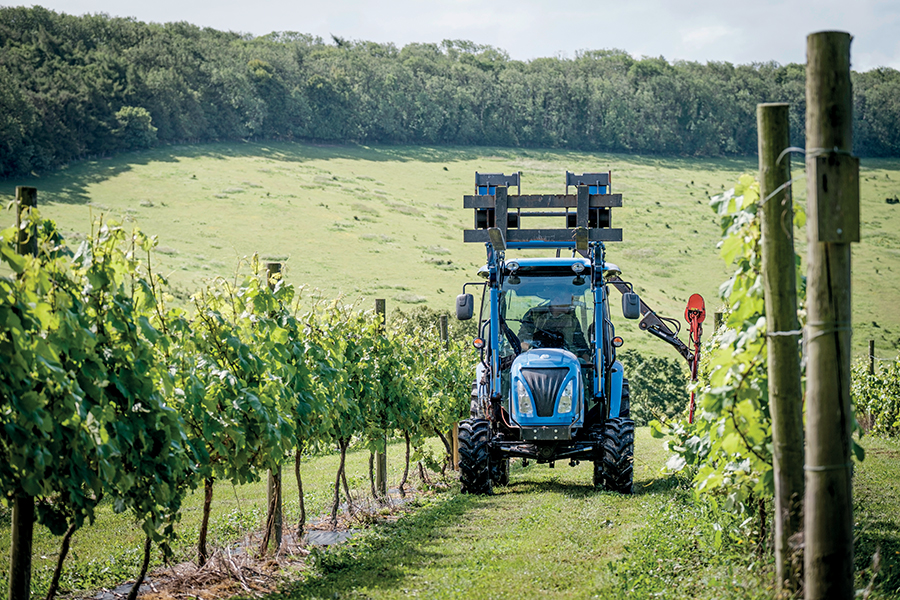
Market Place Farm has been in the Wilson family for over 70 years, and has evolved from being a mixed arable and livestock enterprise, to renewable energy, to diversifying into winemaking and weddings.
Ellie Wilson assists with both the vineyard and winery at Little Wold Vineyard, and has also helped out on the hospitality side in the past; so, despite being one of the youngest members of the family team to join the business, she is certainly is well-placed to discuss the ups, downs and everything inbetween.
“I’m the fourth generation Wilson to work on this farm; my father, Tom Wilson, and his sister, Alice Maltby, run the business with their father and my grandfather, Henry Wilson,” explains Ellie. “We recognise the unique working dynamic this creates, but we also embrace having our work so closely tied to our family; it’s the way this farm has always worked.”
Ellie and her aunt, Alice, both had plans to pursue careers away from the vineyard, with Ellie having undertaken a Master’s degree in creative writing and publishing, while Alice trained originally to be a teacher. But they were both, possibly inevitably, drawn back to the family farming business. Now Ellie uses her skills to assist with the vineyard blog, while Alice realised she had more to give in helping the business diversify into weddings and events.
“However, my father, Tom, has always worked in agriculture; from his early childhood to now, he has always had a love for hard work and being out in the fields. Before Little Wold Vineyard (LWV) was established, Tom worked for several major farms in Yorkshire and North Lincolnshire, and has always been respected for his dedication.
“He now manages the vineyard aspect of LWV, bringing all of his prior knowledge and understanding of the land he grew up on to help us keep the vines in good health.”
There had been many attempts by the Wilson family to branch out and diversify over the years before LWV was born, from Christmas trees to sustainable willow projects – so it would be fair to say that they have never been afraid of stepping into the unknown.
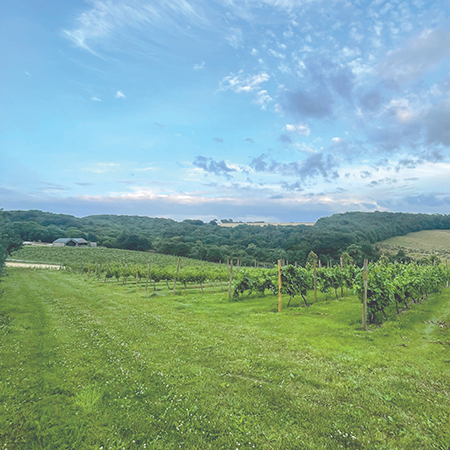
Ellie’s grandfather, Henry, came up with the idea for diversifying the farm into a vineyard in the early 2010s whilst away visiting family in South Africa. He did some research on his return home and was delighted to find Stewart Smith, a vine expert, was located just a few miles down the road in Malton.
Stewart visited Henry’s proposed site and gave the thumbs up to the project. Soil samples were taken and a range of vine varieties were matched to the site. These included some familiar varieties such as Chardonnay and Pinot Noir, along with some more typically ‘English’ varieties such as Rondo, Madeline Angevine and Solaris.
“Having spent his entire life working on the farm and being in need of a ‘retirement project’, he felt that a vineyard would be the perfect solution. It’s probably important to note here that Henry, unsurprisingly, is no longer in retirement,” smiles Ellie.
First plantings
By the turn of the 21st century, the farm could no longer compete with larger estates, and much of the land was sold for building. What remained was converted into meadow/grassland.
“This is actually where one of our wines, Poppy Hill, gets its name from, as during this time many of the fields grew this wildflower, creating beautiful landscapes,” Ellie explains.
“The earliest vines were planted in 2012. If you ask Henry about the location of these vines, he’ll tell you that he planted them somewhere that people were less likely to notice them – on the off-chance his idea did not work.
“As it happens, the retirement project was a success, and we now have vines in most of our fields surrounding South Cave. Our youngest vines were planted in 2022, using a piece of equipment Tom built from scratch with the help of some friends, which he hoped would make the process slightly more bearable.
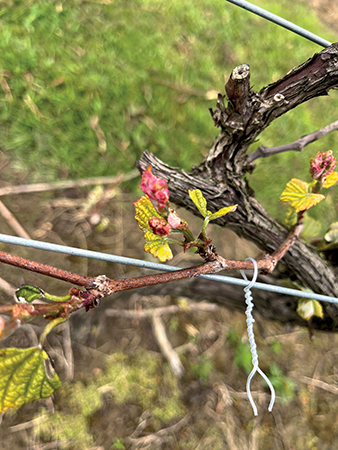
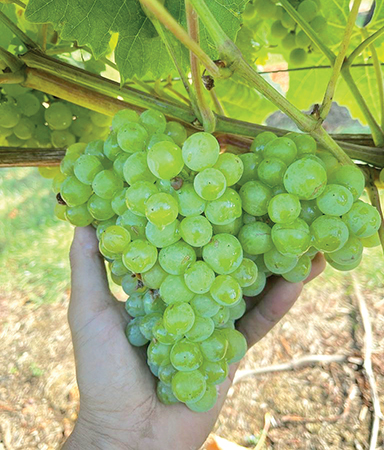
“Prior to this invention, the vines had been hand-planted, which was fine when Henry was trialling the idea of a vineyard, but not ideal for Tom and the thousands of vines he needed to plant.”
Tom’s vine-planting aid attaches to the back of the tractor and allows someone to be carried along, placing the plant into the trench dug out for them.
Harvest success
The first five years gave very little income from such a large investment (both in money and time) but all the hard work is starting to pay off, says Ellie. “We’ve improved massively from our earlier years, as you’d expect. For example, in 2017 the total yield was 6t; in 2021 we produced 13.5t, and this jumped to 19t in 2022.
“Despite the poor weather in 2023, we had our most successful harvest last year, bringing in around 32t. We had predicted around 40t, but due to the summer being wetter than anticipated, we experienced more disease in our Madeline and Phoenix varieties, which is where we lost around 8t of produce.”
While the 2023 yield was LWV’s largest to date, the quality of the grapes was well below what they usually aim for at harvest. The lack of sun meant the grapes were struggling to ripen, and they were waiting until mid-to-late September to start picking in the hopes that this extra time would allow the grapes to develop the sugars they needed. Waiting like this also left the vineyard more susceptible to disease and pests, such as wasps.
However, points out Ellie, this year’s growing season has been a particular challenge. “The inconsistency in weather has made it difficult for Tom to keep on top of spraying, and has left the team worried about disease making its way onto the vines.”
Harvest usually occurs around the middle-to-end of September, although this year LWV is anticipating it to start as late as October.
Pests and diseases
LWV typically suffers from the three most common diseases – downy mildew, powdery mildew, and botrytis. While LWV’s viticulturist, Cameron spots the signs for these, Tom’s agricultural history and qualifications means it’s primarily up to him to spray the vines regularly.
“This works quite well for us, as while Tom is spraying Cam is often working in another vineyard, where he can track any signs of disease and let Tom know,” explains Ellie.
“Tom uses Karma to control and stem our mildew problems, although unfortunately once mildew has set in to the vines it can be difficult to contain it. This has been especially difficult for us this year with persistent rain meaning spraying has been almost impossible to do consistently or in a way that would be effective.
“As for pests, deer tend to be our worst problem at LWV. Our relative isolation and the woodlands that border us mean we are a prime spot for deer to come to as a food source. We have tried our best to humanely resolve this, by installing fencing that makes it difficult for them to access the vines, although this isn’t always the right solution for us, especially for the vines that surround our tasting room, which is often visited by members of the public and used for weddings and other events.”
Canopy management and harvest
The vineyard is mostly maintained all by hand. The canopy is managed through tucking in, which the team do a few times in the early stages of shoot and leaf growth, but later they trim back the growth – often by hand, but sometimes mechanically.
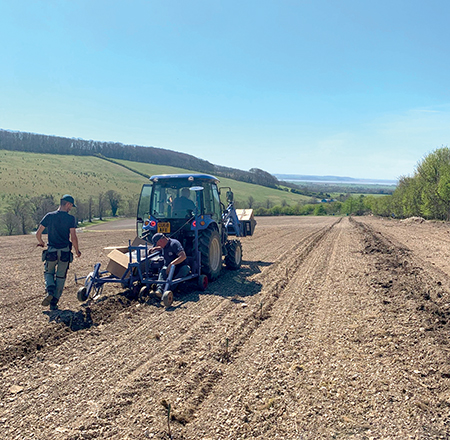
LWV owns two smaller tractors – a John Deere and a New Holland, both of which are second hand – along with a fan-assisted sprayer. “Our sprayer is a specific model which comes from Poland, and is more suitable for soft fruits and greenhouse use. The problem is that all of our parts have to come from the original makers in Poland, which means when we need to replace something it can take some time to get to us – impacting the consistency of the spraying we do,” says Ellie.
As for other technical equipment on the vineyard, much of it is built using pieces Tom and Henry would have used for more common agriculture practices. Purchasing a de-leafing machine was not a possibility for Tom, and so he repurposed a combine side knife, which he uses to trim off excess growth in the vineyard.
“As with our planting machine, these less-than orthodox methods of mechanising may not sound ideal, but for us it’s really been our only option,” shares Ellie. “Our sources are limited compared to our southern vineyard counterparts, and as a UK vineyard in general it is difficult compared to the European vineyards.”
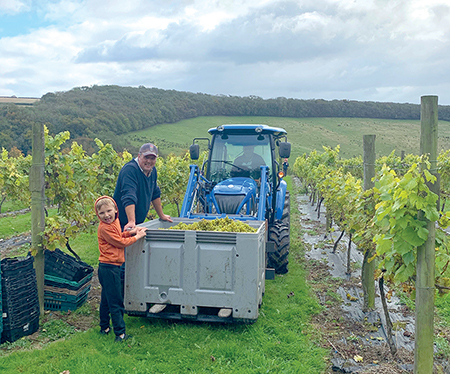
LWV uses the gentle pruning method, which means they prune according to the individual vine. “This is a less straightforward process than the cordon method, as we assess the vine before determining which canes we will keep and spare before removing the rest of the plant. While it’s a longer method to do, we feel it produces better results,” comments Ellie.
Grapes are handpicked across all the vineyards, with members of the events and hospitality teams all chipping in, along with local pickers brought in through a volunteer programme, which runs from early spring through to the end of harvest. “This group of individuals has kept LWV running,” shares Ellie. “They’re willing to go above and beyond anything we would expect of them; it’s safe to say that without their help, we could not complete harvest.”
Wine production
LWV produces all of its still wines, although this has not always been the case.
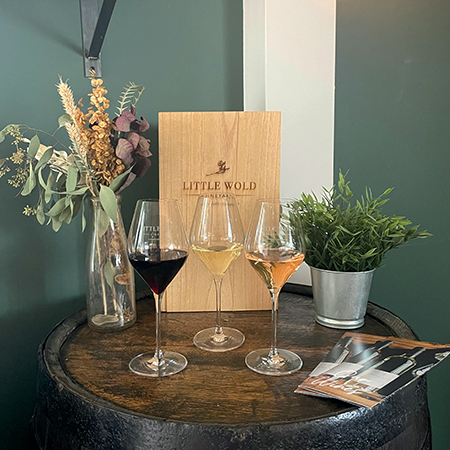
“We originally started by sending the grapes to Half Penny Green, who are well-known contract winemakers, and they still make our sparkling wine, using the traditional double ferment method,” says Ellie.
“But in 2021 and 2022, Tom built the winery, with the help of myself and Cam, allowing us to make our own still wines for the first time in 2022. We haven’t sold on any of our grapes before – although we have been asked if we would be willing to in previous years, we’ve always wanted to keep what we produce for our own wine.”
LWV offers five still wines in total – three white wines, Chalk Hill, Barley Hill and James’ View; a rosé, called Poppy Hill; and a red, called Three Cocked Hat. “All of our wines have names that revolve around the farm and its history. We’re very proud of our little farm and all it’s been through, and we hope that in sharing these names we are able to give people a little snippet of the history of LWV,” says Ellie.
All of the wines lean towards the dry end of the spectrum, due to the reduced level of sun on the vines, meaning the grapes aren’t able to produce the kind of sugars you’d need for sweeter wines.
Winery building and marketing
The winery was a lockdown project, completed by Tom in between looking after the vines, pretty much on his own. “At this point, we had no additional staff in for events or the vineyard, it was a real family effort to keep the farm running; Alice manned many of the wedding elopements on her own while trying to keep the sales of our wine going, which was how we were to fund both the building of the winery and the extension of the tasting room.
“The job wasn’t easy, and Tom had to work quickly once he, Alice and Henry decided that they wanted to produce their own white wine in 2022. But, like most things Tom does, he completed the job in time, and at a much cheaper cost than we would have expected to pay if we had hired contractors to build the winery. The equipment was sourced second hand for the most part, with the help of Kieron Atkinson from The English Wine Project.”
Around 80–90% of LWV’s wine is sold through their weddings and other events they hold, as well as via online sales and through the ‘cellar door’ which they have open twice a week, on Fridays and Sundays from 11am-4pm.
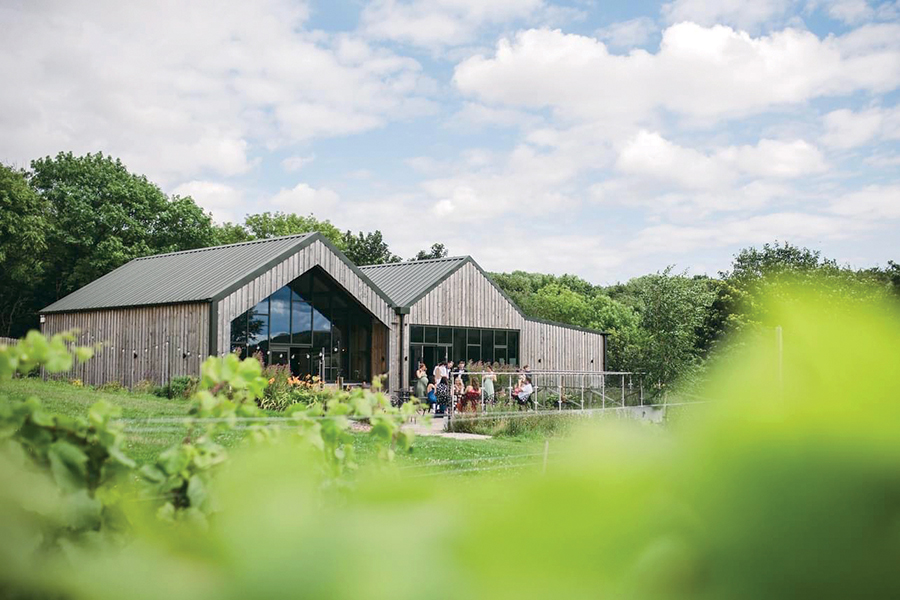
“Prior to lockdown, we had started looking into wholesale, but we had to withdraw from this to sell ourselves to make maximum profit; with the extension of our tasting room and events we were offering as we came out of lockdown, we realised we needed to evaluate how much we needed to keep before we returned to wholesale,” explains Ellie.
“Now, roughly two years on, we are looking to go back into wholesale. We do sell in some local farm shops and restaurants, who we love to work with and support.
“Much of our marketing is social media based, but being a relatively standalone business, offering events and wine, in our area means word of mouth has also been hugely important for us. We are very lucky to live among people who believe in supporting local business, who believe in leaving lovely reviews and sharing us with people across the country.”
Diversifications and sustainability
LWV started running weddings in 2016 – a venture of Alice’s, and her main reason for returning to the farm after a short stint as a teacher.
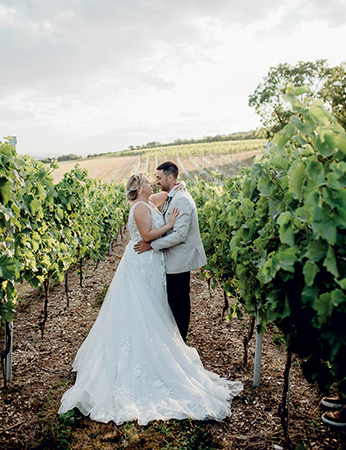
According to Ellie: “Alice’s business-oriented mind has allowed us to expand into something none of us anticipated. We now do corporate events, tastings, tours and charity events for local businesses. This has worked very well with the vineyard, and the two co-exist now in a way that makes it hard to picture one without the other.”
LWV was recently asked to undergo a carbon neutral investigation, and the results were impressive to say the least. For the size of the farm, the amount of chemicals they use is minimal, and with almost no need to cultivate the land, on top of all the land we leave as wildflower and meadow, the land is as close to carbon neutral as is possible, according to Ellie.
“We did make the conscious decision to remove the foil casing from our sparkling wines a couple of years ago, and have also made an effort to reuse our cardboard packaging where we can (we have no plastic packaging for our wine) to transport the wine from storage. We are always looking to be more sustainable, and with regenerative viticulture on the rise, I am hoping to work on this as I continue to grow into my role on the vineyard,” she shares.
Facing challenges together
“I think we can all admit that finance has been one quite difficult challenge for us,” says Ellie. “LWV was a diversification plan – a dream to keep the farm running, a farm which had been given up on as a small holding, which could never compete with the big businesses and housing developers buying up the land around it.
“While we joke that it was a retirement plan, it was also the family’s last shot at being more than land sat waiting for building permission. And thankfully, it’s worked, but it has never been smooth sailing. We’re always in need of something, that’s either ridiculously out of budget or only ships to EU countries. So you could say we’re always on the back foot. But we work together to make it all work. And I think we can be proud of that.
“Our location will always be the biggest challenge for us. I think Henry, Tom and Alice always knew we were out on a limb when they pushed forward with LWV, but as we’ve grown we’ve really felt the impact of this. Particularly when it comes to networking with other vineyards, I personally can recount times where people have been surprised that we exist, and have had people assume that we are not ‘serious’ about what we do – presumably because they think a vineyard situated eleven miles from Hull cannot be a good vineyard.
“This kind of adversity and ostracising is not something we alone experience, and I’m sure many northern vineyards have similar experiences to share. This is, I suppose, where being a close-knit family, both in the biological and metaphorical sense, really comes in handy. We are here for one another, and we are excited by what the future holds for Little Wold Vineyard.”
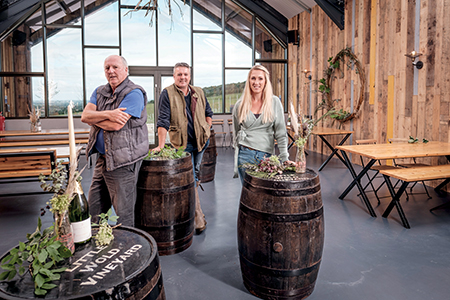
Grower profile:
Location: South Cave, East Yorkshire
Total vineyard size: Total farm area is 75.5ha, including vines, meadows, farmyard/winery and tasting room. Of this, around 7ha is under vine.
The family also manages three other vineyards in the Yorkshire and Lincolnshire area – an additional 2.4ha.
Soil type: Loamy chalk, which combined with the steep incline assists in good drainage.
Aspect: The valley the main sites sit on runs north to south, meaning plenty of sun. The site is 215m above sea level, and the elevation along the valleys protects the vines from frosts most years, although there are one or two frost pockets in some of the vines as the contour of the hillside dips naturally.
Varieties grown: Rondo, Divico, Regent, Madeline, Bacchus, Seyval, Solaris, Phoenix, Chardonnay and Pinot Noir, typically on SO4 rootstock.
Read more grower profiles
Read more vine news
